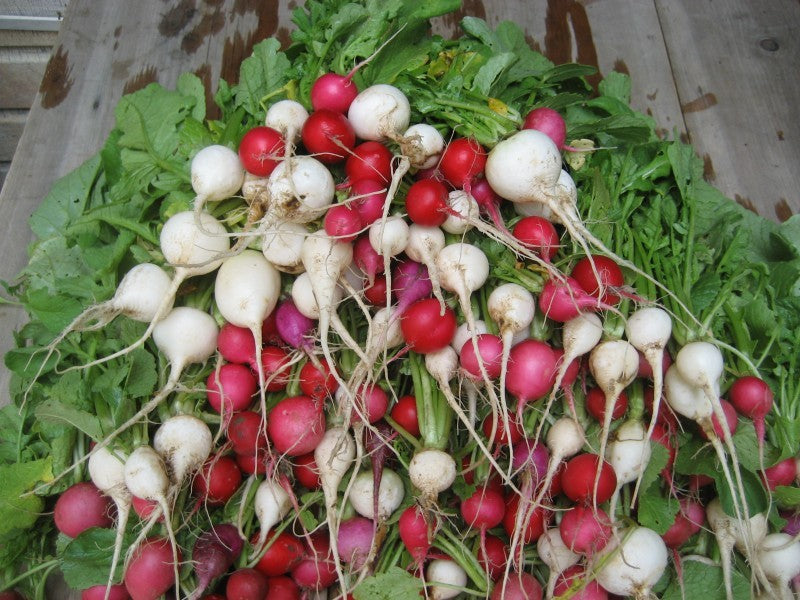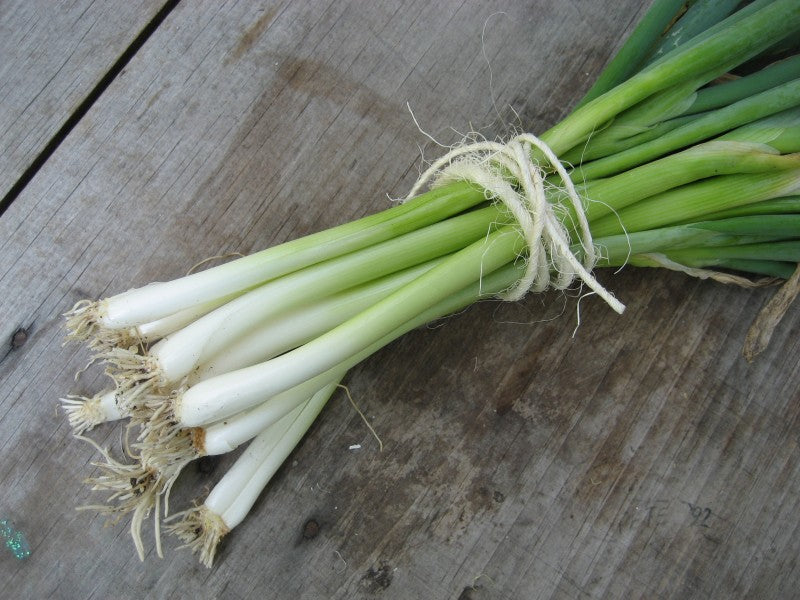Once we are past Imbolc, with half the winter safely behind us, it’s time for gardeners to turn their thoughts toward spring and the first task of the season: seed starting. The sowing season begins in February with varieties that need a long warm season and goes through May, with crops that are ready to grow directly in the garden after the last frost has passed. Between now and then, every week presents new opportunities for starting seeds. Below are two useful categories for organizing your sowing calendar, with some of our favorite varieties within:
Direct Sow as Soon as Soil Can Be Worked
As the saying goes, the early bird gets the worm! Some spring vegetables perform best when sown as early as possible and hate the heat of summer. Sow these varieties outdoors as soon as the soil can be worked.
When is soil ready to be worked? You can begin sowing in late winter or early spring--but not until the soil is ready. Many cool-weather crops benefit from being sown as early as possible. Germination may take a bit longer than under warmer conditions, but they'll be off and running early, thus getting the maximum growing time before summer heat sets in. Just be sure to wait to sow until the soil has recovered from the winter freeze and has returned to a friable, arable state. The top several inches should be dry and crumbly enough that the soil doesn't stick as you run a tool across the surface but instead falls away in small chunks or crumbles. Clay soils can take 1-2 weeks longer than sandy soils to become planting-ready. As you continue to add organic matter to your soil over the years, it will become lighter and more easily worked at the start of the season.
Tall Telephone Pea: AKA Alderman. This open-pollinated shelling pea is hands down our favorite. Vines are covered with long, easy to shell pods, filled with 6-8 plump peas. This variety doesn't get as starchy as other shelling peas we have tried. Sow: In early spring, as soon as soil can be worked. Grow: Tall vines reach 6' and require trellising. Can tolerate some shade, and prefers some after the heat sets in.
Wild Arugula: If you already like arugula, you'll like wild arugula even more. If you already dislike arugula, well, steer clear. Wild arugula has an amplified arugula flavor, while its smaller leaves and pretty color make for a refined impression. Grab a small handful and toss chopped into a salad for a terrific arugula bite, or steam older leaves for use as a side green. Sow: Wild arugula can be direct sown as soon as soil can be worked. The cool-loving green doesn't particularly like mid-summer, but it will do well most of the season: keep on sowing! Grow: Harvest when young for fresh use, when slightly older for braising. Very hardy and will grow through winter with the protection of a cold frame or low tunnel.
Evergreen Scallion: Starting a scallion bed is a journey worth taking. They are an indispensable, easily grown part of any garden. Chopped and sprinkled on nearly any prepared dish, they make all flavors pop. A bed of scallions will prove useful to you all season. Sow: Direct sow beginning 4 weeks before last frost, or start your first round of scallions indoors up to 12 weeks before last frost date. Make succession sowings every 3-4 weeks for scallions all season. A good fall crop can be started about 3-4 months before first autumn frost. Scallions are tolerant of less-than-ideal conditions. Grow: Scallions will multiply by division naturally if left unharvested. Overwintered scallions emerge powerfully after frost, their deep green spears a reassuring sign of spring.
Easter Egg Radish: Easter egg radishes grow quickly and soundly into slightly larger-than-average roots that take on pastel hues: pinks, purples, and whites. Their texture is crisp-juicy and they hold well without getting "empty spots" within. Sow: Begin direct sowing a week or two after the soil is first ready to be worked, then continue sowing these fast growing roots in succession. Keep well watered, especially as the season warms up. Grow: Harvest radishes as soon as they are round, there is a small window to harvest them before they split. Store radishes without the top to keep roots firm (but enjoy the tops in a saute mix). Easter Egg Radishes do well in the fall too, when the roots can get positively enormous and still taste great!
Bloomsdale Spinach: One of the most glorious greens of cool weather with succulent, slightly savoyed, dark leaves that have mesmerized across cultures and generations - from a French queen to Popeye the Sailor to modern day nutritionists. Sow: Direct sow Bloomsdale Spinach anytime soil can be worked in the cooler months, from about 6 weeks before first fall frost until the date of your last spring frost. Grow: Harvest promptly, especially in late spring, when it tends to bolt under heat pressure. Fall crops yield until deep winter; with a cold frame, you can be eating spinach all winter long.
Sow Outdoors Early: Don’t know how to choose? Then grow your spring garden with these six hardy favorites: Tall Telephone Pea, Wild Arugula, Bloomsdale Spinach, Evergreen Scallion, Easter Egg Radish, Early Wonder Tall Top Beet.
Starting Indoors: Spring Hardy Varieties
Get a head start with varieties that can be transplanted outdoors well before your last frost. Crops in this category are hardy enough to tolerate the unpredictable weather of early spring, but for earliest harvests, they can be sown indoors in winter, then moved into the garden once the spring soil is workable.
Chives: The smallest of all the Alliums, chives are considered to be the only species of Allium native to both the Old World and the New. The sulfur smell of the plant is said to repel garden insect pests while the flowers attract beneficial pollinators. This clumping onion survives winter in the Northeast and often blooms in early May. Sow: Start seeds indoors, about a week before outdoor soils can be worked. Keep watered but not wet. Transplant outdoors in clumps when chives are about 3" and the soil can be worked. Grow: Chives will grow slowly at first, but are extremely hearty and fast growing once established. For best culinary quality, cut chives every week or two once they are established. The chive flowers are also edible when they are soft and pink.
Vates Blue Curled Kale: This traditional crunchy kale shines in the cool weather garden. Delicious when braised and its rigid texture holds its own, never melting away like a less crinkly variety. Plants are compact but productive and can be harvested for weeks and weeks. Sow: In early March for a mid-April transplant. Sow again in late June or early July for a fall crop. Grow: If sown in March, begin harvesting (up to two thirds of the outer leaves at a time) in May. Give the plants highly fertile soil.
Early Jersey Wakefield Cabbage: By 1888 Early Jersey Wakefield was the most popular early cabbage in American gardens. In 1895, Peter Henderson gave it a rare New York-New Jersey compliment calling it the "best early cabbage in cultivation." In 1901, 166 seed companies carried this variety. Unlike the disappearances of many previously popular rock stars and heirloom vegetables, Early Jersey Wakefield can still sell out a stadium and the USDA still lists it among the principal varieties of American cabbage. Sow: Sow indoor in early March (and perhaps again in early April). Start transplanting in mid-April. Grow: These cabbages form a pointy head very quickly and are available for harvest from late June through August.
Blau Gruner Leek: This blue-green variety produces heavy, dense, stout stalks that sweeten up in the fall/winter. Sow under protection in late winter or early spring, then transplant any time after soil can be worked. Make a hole about 8" deep and drop sturdy seedlings into the hole. Allow rain to wash soil into hole, slowly filling it. Harvest at pencil-thin stage for baby leeks or anytime thereafter. Sow: Indoors in late winter or early spring, then transplant any time after soil can be worked. Grow: Leeks can be harvested at pencil-thin stage for baby leeks or anytime thereafter. If you wait till fall, you’ll be rewarded with a large, dense, sweet storage leek for winter.
Rainbow Chard: This bright chard mix satisfies everyone's end-of-the-rainbow wishes, with succulent leaves in shades of red, yellow, orange, and cream. Grow this chard and you'll see: a good garden is more valuable than a pot of gold. Sow: Direct sow beginning 2-3 weeks before last frost, or start indoors 3 weeks earlier and transplant. Grow: One sowing will provide harvestable greens all season, though it's smart to do a mid-summer sowing in case disease pops up. Sowing monthly in succession would provide a steady crop of the most tender, young leaves. Like all plants harvested for their leaves, chard appreciates fertile soil.
Six Seeds to Sow Early Outdoors: Don’t know how to choose? Then grow your spring garden with these six hardy crops that thrive when started early outdoors under protection: Chives, Vates Blue Curled Kale, Early Jersey Wakefield Cabbage, Champion Collards, Blau Gruner Leek, and Rainbow Chard.
What will you sow first?











